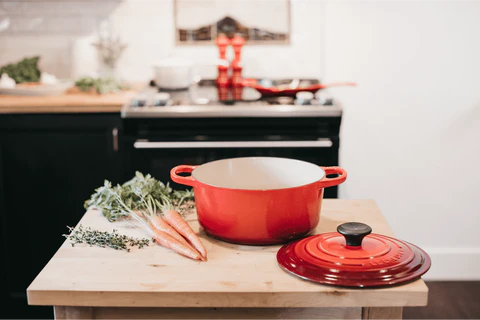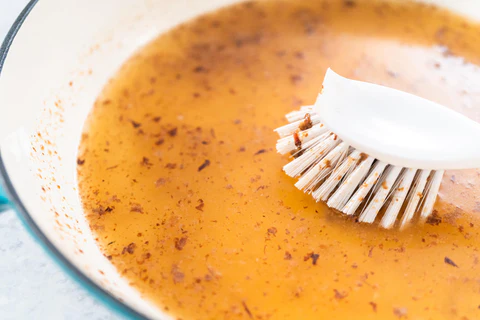How To Care For And Clean Enamel Cookware
People love enamel-coated cookware for a reason. It distributes heat evenly, looks beautiful and makes you feel like a pro in the kitchen. High quality porcelain enamel cookware has a thick enamel coating that makes it hardwearing and easy to cook with. It is easy to clean, naturally non-stick, and resistant to stains and scratches, as long as it is treated well. But take your eyes off the stove for too long and that coated cast-iron or steel becomes a mess of burnt food, no matter what you’re making.

Care Tips for Enamel Cookware
No matter if you inherited enameled cookware as a family heirloom or just bought a brand-new set for yourself, learning how to clean and care for this cookware will help it last for decades and keep it ready to pass down to the next generation. We’re going to share a few easy tips and tricks to protect your investment, but wanted to start by mentioning the common types of enameled cookware. The most common enameled materials for cooking are steel, stainless steel, cast iron, and aluminum. We recommend using cast iron or stainless steel because these offer the most consistent cooking results and durability.
That said, enamel is a fired on, glass-like coating which can be susceptible to chips or cracks. You can use metal utensils as you normally would, but be careful not to forcefully strike the edge or the inner sides of the pot. If your enamel cookware does develop some minor cracks or chips, it’s not the end of the world! Chips and cracks happen, but the real cooking power comes from the cast iron or stainless steel underneath the layer of enamel.
A couple more measures you should take to keep your enamel intact, especially if you already have some chips or cracks:
- Don’t subject your enamel pot or pan to dramatic temperature changes, especially near moisture.
- Don’t heat an empty pot or pan. Use on low to medium heat; reserve high heat for boiling water or cooking dishes with plenty of liquid.
- Lift to move your enameled cookware. To prevent scratching ceramic or glass cooktops, or damaging your cookware bottoms, never slide enameled cast iron around.
- Preheat with a little butter, oil, or water each time you cook for easier cleanup later. Skip the nonstick cooking sprays. It can damage the coating and it’s difficult to clean.
- Always dry cookware thoroughly and place pot protectors between the rim and lid before storing in a cool, dry place. Do not stack cookware.
How to Clean Enamel Cookware
It’s okay to run enamel cookware through the dishwasher, although it’s not the best habit. Those beautiful colors will fade with repeated exposure to heat—the same reason you shouldn’t exceed medium on the burner. And soaking your coated cookware in soapy water for a few days doesn’t always do the trick, especially when you’re dealing with finicky residue like crusty cheese or burns on the bottom of the pan. (We too have learned the hard way that cheese and enamel cookware don’t mix.)

The best way for everyday cleaning is warm water, dish soap, and a nylon brush or non-metal sponge.
Got residue that won’t budge after days of soaking?
It’s time to break out some super valuable team players. You can apply all the elbow grease you want, but you’ll need a chemical reaction or an abrasive substance to completely clean out that crusty enamel dish. Enter your new best friends: baking soda, vinegar, and hydrogen peroxide.
First, determine: does this residue just need scrubbing with a little more texture, or are you dealing with a mess of a mess? If it’s the first scenario, you can likely clear it with baking soda, a dish brush or mildly abrasive sponge, and some exerted pressure. If the situation requires reinforcements, you’ll need to lift the gunk with a fizzy substance like hydrogen peroxide (on its own) or baking soda combined with vinegar. Don’t resort to anything metal, because that will lead to scratches and we know that cookware was expensive.
For stubborn stains, start with your fizzy solution of choice. The chemical reaction will help to lift most of the mess, meaning you can save your energy for the tough stuff. Any spots that withstood the fizz will need a mixture of abrasion and pressure. Pour baking soda over the char. If you like, you can make a paste by combining it with either dish soap or water. Then, press down hard with your cleaning utensil and use circular motions.
Burn Marks Not Coming Out?
You might need to turn up the heat, literally. For any burnt food on the inside of the cookware, sometimes the best thing to do is add heat to the cleaning process. Fill your cookware with enough water to cover the burn marks. Bring the water to a boil, add some baking soda, then give it a good stir and let it simmer for a few minutes. Turn off the burner and gently scrape the pan with a wooden spatula or a nylon scrubber. All those burned bits of food should release from your enamel pot after a little bit of elbow grease. Wash the cookware with hot water and dishwashing liquid, and dry.
How to Prevent Burn Marks
The first thing you should do before using enamel-coated cookware is to make sure it’s clean. Add heat to food residue, and you get smoke (or even fire), which just creates a bigger mess. You also may want to wipe down your stovetop before heating up a coated dish, because a dirty stovetop can cause even more smoky marks on the bottom. Priming your enamel cookware, especially pans, with butter or oil will help cut down on residue from burns. By creating a layer between the surface and the food, you’re preventing bits of food from getting stuck and leaving crust behind.
If you can, remove residue as soon as possible. Some enamel-coated cookware isn’t recommended for use with high temperatures at all, so check your packaging or manual. If you must turn that burner up, do it gradually—this applies to lowering the temperature as well. Lastly, don’t try to multitask too much or abandon your enamel cookware for too long on the stove. Keep an eye on that coveted pan!
